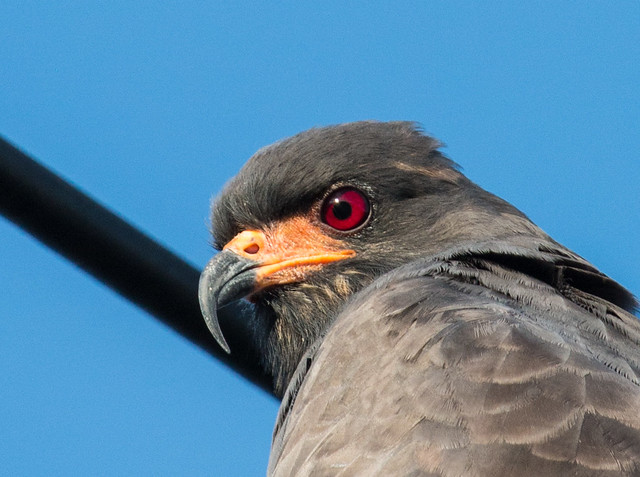Snail Kite
| Rostrhamus sociabilis | Order: Accipitriformes | Family: Accipitridae (Hawks, Eagles, and Kites) |
The splendid Snail Kite was once critically endangered in Florida. It has an entry in the Guinness Book of World Records:
Snail Kite (Florida subspecies): Most restricted diet for a bird. The southern Florida subspecies of the Everglades kite (Rostrhamus sociabilis plumbeus) has the most specialised diet of any bird, living exclusively upon a single species of snail, the large freshwater apple snail (Pomacea paludosa).
Tragically, this entry is in error. This kite does feed exclusively on apple snails belonging to the genus Pomacea, but it’s not particularly fussy regarding the exact species. Historically, its diet was limited to the only apple snail found in southern Florida, Pomacea paludosa, which feeds on detritus in its natural sawgrass habitat. The snail’s diet reduces decaying matter in the water, keeping it well oxygenated and the sawgrass and other native vegetation healthy. The kite’s uniquely shaped bill is perfect for extracting the snail from the shell.
Tragically, people have discharged so many nutrients into the Everglades that the habitat is critically endangered, along with the Florida apple snail. But at the same time, other apple snails popular in the aquarium trade, including Pomacea bridgesii , native to South America, have been released into Florida, and now the Snail Kites have expanded their diet to include them. These invasive snails feed voraciously on living plant tissue and are hastening the destruction of the Everglades. The two U.S. birds best adapted to eat native Florida apple snails, the Snail Kite and the Limpkin, don’t seem to notice the difference between the native snail and the invasive ones, though unfortunately, they’re not making a dent in the invasive snails’ increasing numbers. Now both Limpkins and Snail Kites are increasing, so much so that both species have become rather common even in Orlando, and Limpkins are appearing here and there in states outside Florida, even in the Upper Midwest, too, but now neither species is found so easily in the Everglades where they were once so characteristic.
Laura's Published Works
Radio Programs
- Wild Florida 2023
- Lake Tohopekalipa 2023
- Kissimmee! 2023
- Snail Kite 2023
- Gray-headed Swamphen 2023
- Road Trips 2021 2021
- Passport to Adventure, Part I 2017
- Hurricane Update 2017
- Pupdate: Pip at Eleven Months 2015
- Snail Kite: The Bad News 2015
- Snail Kite: The Good News 2015
- Florida in May (UD) 1997
- Florida Birds 1988
- Preparing for a trip 1988
